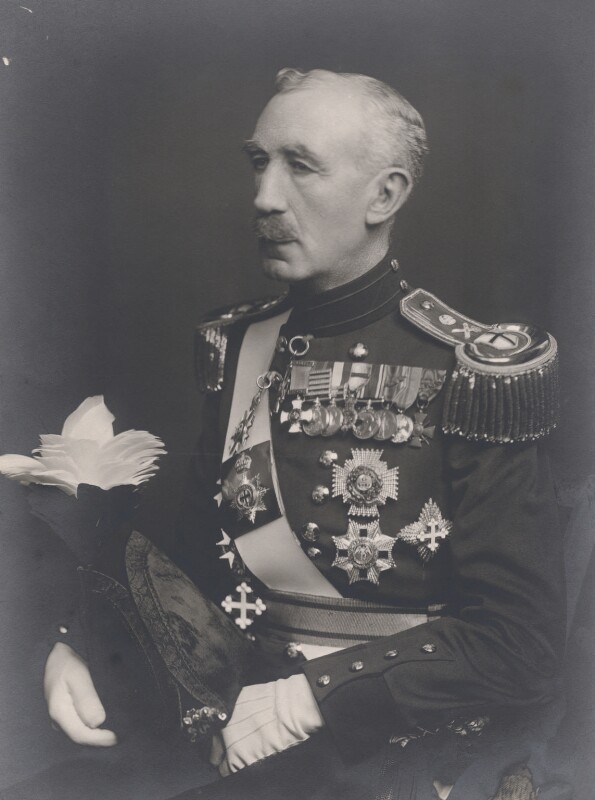The Cavalry Corps was established by an Army Order of 10 October 1914. Major-General Allenby was promoted to temporary Lieutenant-General and placed in command.
Headquarters locations
- Berthen
- 18 October 1914: Mont Noir
- 22 November 1914: Chateau de la Motte-aux-Bois
- 25 April 1914: advanced HQ established at La Lovie Chateau near Poperinghe
- 2 May 1915: advanced HQ moved to Houtkerque (until 4 May)
- 17 May 1915: advanced HQ established at Wippenhoek
- 19 May 1915: advanced HQ moved to La Lovie (until 28 May)
- 5 August 1915: Thérouanne (by 1 October an advanced HQ had moved to Allouagne)
- 19 October 1915: Lumbres
The Corps ceased to exist between 12 March and 4 September 1916. Only a nucleus staff was retained.
- 4 September 1916: Daours
- 29 September 1916: Château de Régnière-Ecluse
- 6 April 1917: Duisans
- 20 April 1917: Château de Régnière-Ecluse
- 19 May 1917: Le Catelet
- 14-15 July 1917: Aire-sur-la-Lys
- 20 October 1917: Beauqesne
- 15 November 1917: Villers-Carbonnel
- 20 November 1917: advanced HQ established at Fins (to 27 November)
- 30 December 1917: Le Catelet
- 10 March 1918: Villers-Carbonnel
- 21 March 1918: Moreuil
- 25 March 1918: Querrieu
- 6 April 1918: Rivery
- 11 April 1918: Auxi-le-Chateau
- 13 April 1918: advanced HQ established at Equierre then St. Andre Farm (near Aire)
- 14 April 1918: advanced HQ moved to St. Quentin (near Aire) (to 5 May)
- 7 August 1918: advanced HQ established at Yzeux
- 8 August 1918: advanced HQ moved to Longeau
- 12 August 1918: advanced HQ moved to Saint-Fuscien (to 16 August)
- 26 August 1918: advanced HQ established at Haute-Clocque (to 18 September)
- 27-28 September 1918: Bois de Bussu
- 1 October 1918: Bois de Gurlu
- 8 October 1918: advanced HQ established at Estreés
- 9 October 1918: advanced HQ moved to Serain
- 10 October 1918: advanced HQ moved to Bertry (to 14 October)
- 14 October 1918: Bois de Bussu
- 7 November 1918: advanced HQ established at Seclin
- 10 November 1918: advanced HQ moved to Genech (to 13 November)
- 13 November 1918: Tournai
- 17 November 1918: Silly
- 18 November 1918: Braine-le-Comte
- 21 November 1918: Genappe
- 22 November 1918: Namur
- 27 November 1918: Huy
- 28 November 1918: Ouffet
- 29 November 1918: Stavelot
- 11 December 1918: Spa (where it then remained)
Commanding Officers
- Lieutenant-General Edmund Henry Hynman Allenby (to V Corps 7 May 1915)
- 7 May 1915: Lieutenant-General the Hon. Sir Julian Hedworth George Byng (to 18 August 1915)
- 19 August 1915: Lieutenant-General Hew Dalrymple Fanshawe (to V Corps 23 October 1915)
- 24 October 1915: Lieutenant-General the Hon. Cecil Edward Bingham (to 4 March 1916)
- 4 September 1916: Lieutenant-General Sir Charles Toler MacMorrough Kavanagh

Unusual incident
On 4 August 1915, Major Raymond Sheffield Hamilton-Grace of the 13th Hussars, in the role of General Staff Officer with the Cavalry Corps, was killed in a motor accident at Bergues. He was brought for burial in the family vault of Baron de la Grange, owner of the Chateau de la Motte-aux-Bois where the corps was headquartered at the time. In 1922 his remains were reinterred at Nieppe Bois (Rue du Bois) Cemetery. Aged 34, he had already been twice mentioned in despatches and awarded the French Croix de Chavalier de Legion d’Honneur. His son, who was given the same name, was born five days after his father met his death.
Battles and Engagements
The Battles Nomenclature Committee of 1921 defined the Cavalry Corps as participating in the following:
Under direct command of General Headquarters of the British Expeditionary Force
The Battle of Messines, 1914 (12 October – 2 November 1914)
Third Army
The First Battle of the Scarpe (9-14 April 1917)
Third Army
The tank attack (20-21 November 1917)
Fourth Army
The Battle of Amiens (8-11 August 1918)
Fourth Army
The Battles of the Hindenburg Line:
The Battle of Cambrai, 1918 (8-9 October 1918)
The pursuit to the Selle (9-12 October 1918)